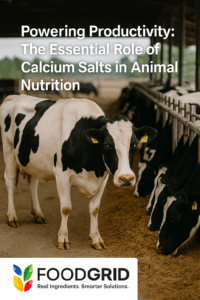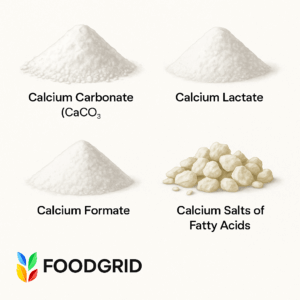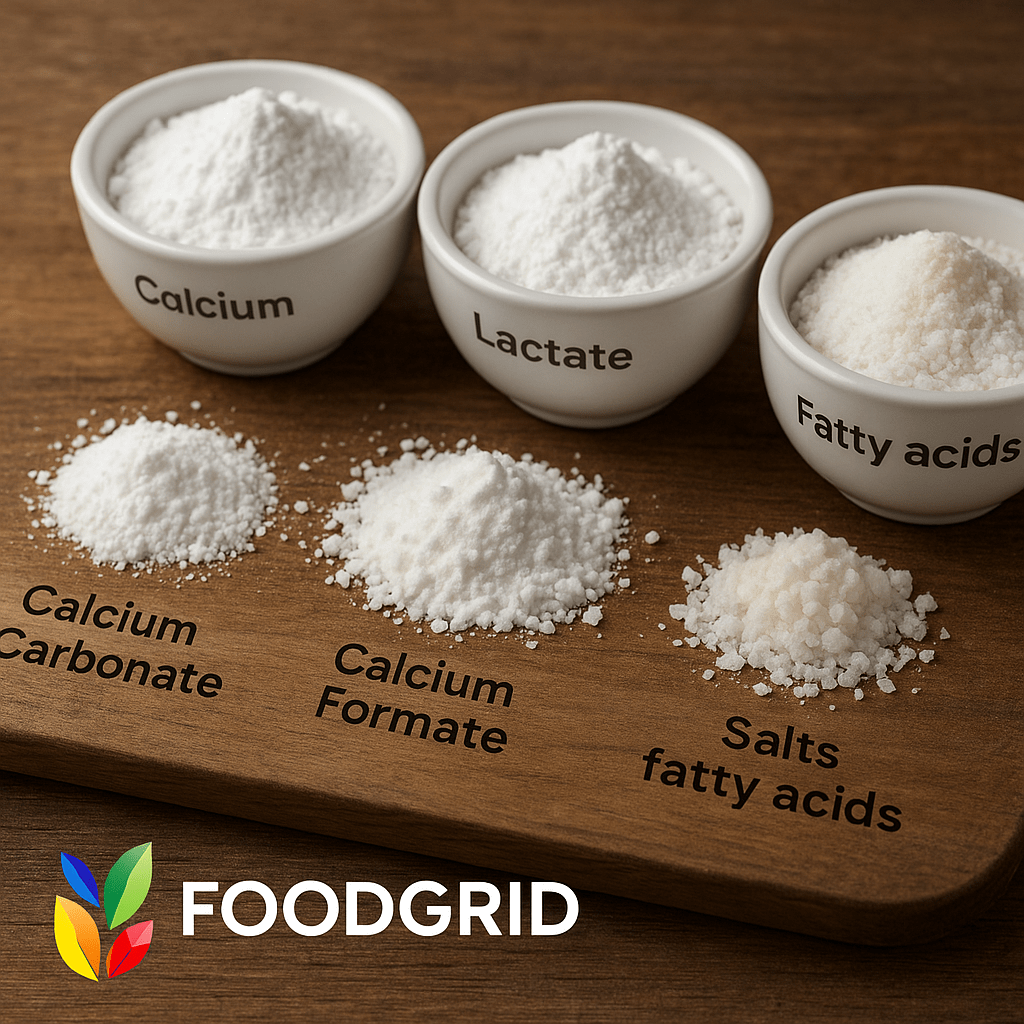Livestock production is the backbone of global food systems, supplying milk, eggs, meat, and aquaculture products to billions of people. To sustain animal health, productivity, and welfare, balanced nutrition is essential. Among feed additives, calcium salts are indispensable. They are more than just minerals for bone strength; they are critical to metabolic function, reproduction, gut integrity, and energy efficiency.
As the global feed additives market grows at a projected CAGR of 5–6% through 2033, calcium salts remain at the center of innovation in animal nutrition. Large-scale feed manufacturers, commercial farms, and aquaculture operations rely on these additives to maximize output while aligning with animal welfare standards and sustainability goals.
This article explores the role of calcium salts in animal nutrition, explains their different forms and benefits, and outlines the four primary buyer personas shaping demand in the livestock feed industry.
What Are Calcium Salts?
Calcium salts are compounds formed when calcium ions combine with organic or inorganic acids. In animal feeds, they are incorporated either as mineral supplements or as functional additives to enhance digestion and energy utilization.
Common Types of Calcium Salts in Animal Nutrition
- Calcium Carbonate (CaCO₃)
- Most widely used due to availability and cost-effectiveness.
- Key role: Supports skeletal development, eggshell formation, and rumen buffering.
- Calcium Lactate
- Highly bioavailable organic form.
- Key role: Improves calcium absorption in poultry and young animals.
- Calcium Formate
- Provides calcium while acting as an acidifier to stabilize gut pH.
- Key role: Enhances gut integrity and reduces pathogenic bacterial growth in swine.
- Calcium Salts of Fatty Acids
- Known as rumen-protected fats or “bypass fats.”
- Key role: Supplies concentrated energy without disturbing rumen fermentation.
Each form serves unique functions, making product selection dependent on species, production goals, and feed formulation strategies.
The Role of Calcium Salts in Animal Nutrition
- Skeletal Development and Bone Health
Calcium is the primary mineral in animal bones and teeth. Adequate calcium supplementation prevents disorders such as rickets in young animals and osteoporosis in layers.
- Milk and Egg Production
- Dairy cattle: Calcium salts support milk yield and prevent hypocalcemia (milk fever).
- Poultry: Laying hens require large amounts of calcium carbonate for strong eggshells.
- Energy Efficiency and Growth Performance
Calcium salts of fatty acids improve energy density in feeds, especially during transition phases in dairy cows or during rapid growth in swine and poultry.
- Gut Health and Feed Efficiency
Organic calcium salts (e.g., calcium formate) enhance gut integrity, reduce pathogen load, and improve feed conversion ratios—critical for swine and aquaculture systems.
- Reproduction and Fertility
Adequate calcium levels influence hormone regulation and reproductive efficiency across livestock species.

Market Outlook for Calcium Salts in Animal Feed
The global feed additives market, valued at over USD 40 billion, is projected to expand steadily due to:
- Rising global demand for meat, milk, and eggs.
- Greater focus on animal welfare and productivity.
- Expansion of aquaculture as a sustainable protein source.
Calcium salts represent a core product category in this growth, with adoption increasing in both developed and emerging markets.
Buyer Personas for Calcium Salts in Animal Feed
To understand how calcium salts are purchased and used, let’s examine four key buyer personas based on industry segments: dairy, poultry, swine, and aquaculture.
- Dairy Nutrition Manager
- Demographics & Role:
Works at a commercial dairy farm (500+ cows). Typically, a farm owner, nutritionist, or feed procurement manager.
- Goals & Motivations:
- Maintain herd health.
- Maximize milk yield and fat content.
- Prevent metabolic disorders (e.g., milk fever).
- Pain Points:
- Transition cow management.
- Cost pressures from fluctuating milk prices.
- Risk of subclinical hypocalcemia reducing fertility.
- Buying Behavior & Preferred Products:
- Prefers calcium salts of fatty acids for high-energy diets.
- Uses calcium carbonate for skeletal support and buffering.
- Buys in bulk from trusted suppliers with consistent quality.
- Poultry Feed Formulator
- Demographics & Role:
Works in integrated poultry operations or feed mills. Responsible for formulating diets for layers and broilers.
- Goals & Motivations:
- Improve eggshell strength and hatchability.
- Maximize feed efficiency in broilers.
- Meet consumer demand for high-quality eggs.
- Pain Points:
- Thin or broken eggshells causing financial losses.
- Volatile raw material costs.
- Need for highly bioavailable calcium sources.
- Buying Behavior & Preferred Products:
- Heavy use of calcium carbonate for layers.
- Calcium lactate used for better absorption in young chicks.
- Seeks suppliers who offer technical support on formulations.
- Swine Producer
- Demographics & Role:
Operates medium to large-scale swine farms or contracts with integrators.
- Goals & Motivations:
- Increase feed efficiency and growth rates.
- Reduce mortality and improve gut health.
- Meet market weight faster without compromising welfare.
- Pain Points:
- Enteric infections (E. coli, Salmonella).
- Increasing scrutiny on antibiotic alternatives.
- Feed cost inflation.
- Buying Behavior & Preferred Products:
- Prefers calcium formate for dual benefits: calcium supplementation and gut acidification.
- Open to blends with organic acids for improved performance.
- Selects suppliers offering trial data and proven ROI.
- Aquaculture Operations Manager
- Demographics & Role:
Oversees feed procurement for fish/shrimp farms in Asia-Pacific or Latin America.
- Goals & Motivations:
- Support skeletal growth and shell formation.
- Enhance feed conversion ratios.
- Improve survival rates under intensive farming conditions.
- Pain Points:
- High mortality from disease outbreaks.
- Nutrient leaching in aquatic environments.
- Limited awareness of calcium salt applications in aquafeed.
- Buying Behavior & Preferred Products:
- Uses calcium carbonate for shellfish and skeletal growth.
- Interested in calcium salts of fatty acids to boost energy in intensive systems.
- Relies on suppliers with expertise in aquafeed formulations.

Internal Links for Additional Reading
- FoodGrid: Animal Feed Solutions → https://foodgridinc.com/
- FoodGrid Blog on Sustainable Feed Additives → https://foodgridinc.com/foodblog/
References
- Food and Agriculture Organization of the United Nations (FAO): https://www.fao.org/animal-production/en/
- National Institutes of Health (NIH): https://ods.od.nih.gov/factsheets/Calcium-Consumer/
- Journal of Dairy Science: https://www.journalofdairyscience.org/
- ScienceDirect: https://www.sciencedirect.com/
- United States Department of Agriculture (USDA): https://www.ers.usda.gov/
Calcium salts—whether in the form of calcium carbonate, calcium lactate, calcium formate, or fatty acid salts—are indispensable to modern animal nutrition. From strengthening bones and eggshells to improving gut health and energy balance, their impact spans across dairy, poultry, swine, and aquaculture industries.
As livestock production faces rising demand, sustainability pressures, and tighter margins, choosing the right calcium salt and supplier is crucial.
👉 At FoodGrid, we provide scientifically backed feed additives that enhance performance and profitability while aligning with animal welfare goals. Explore our solutions here: https://foodgridinc.com/ or connect with our team today to discover how calcium salts can transform your feed strategies.
